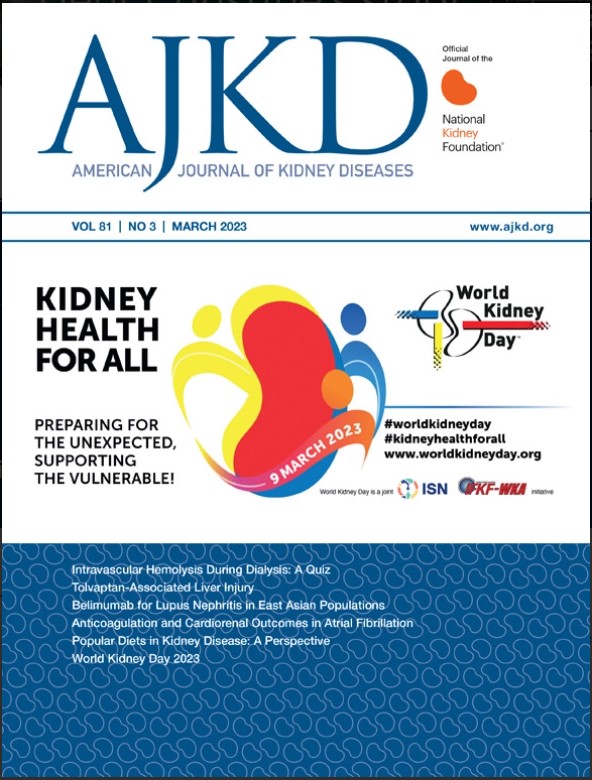胰高血糖素样肽-1受体激动剂和钠/葡萄糖共转运蛋白2抑制剂在预防2型糖尿病和CKD患者慢性肾衰竭和死亡率中的比较效果
IF 8.2
1区 医学
Q1 UROLOGY & NEPHROLOGY
引用次数: 0
摘要
胰高血糖素样肽-1受体激动剂(GLP-1RAs)和钠/葡萄糖共转运蛋白2 (SGLT2)抑制剂可改善2型糖尿病患者的心血管、肾脏和生存结局;然而,这些药物在现实环境中的相对有效性仍不清楚。本文章由计算机程序翻译,如有差异,请以英文原文为准。
Comparative Effectiveness of Glucagon-Like Peptide-1 Receptor Agonists and Sodium/Glucose Cotransporter 2 Inhibitors in Preventing Chronic Kidney Failure and Mortality in Patients With Type 2 Diabetes and CKD
Rationale & Objective
Glucagon-like peptide-1 receptor agonists (GLP-1RAs) and sodium/glucose cotransporter 2 (SGLT2) inhibitors improve cardiovascular, kidney, and survival outcomes in patients with type 2 diabetes; however, the comparative effectiveness of these drugs in a real-world setting remains unclear.
Study Design
Retrospective cohort study.
Setting & Participants
79,047 patients with type 2 diabetes and an estimated glomerular filtration rate <60 mL/min/1.73 m2 in the Taiwan National Health Insurance Research Database between 2016 and 2021.
Exposure
Treatment with GLP-1RAs or SGLT2 inhibitors.
Outcome
Initiation of kidney replacement therapy (KRT) and all-cause mortality.
Analytic Approach
Propensity score matching was performed to balance baseline characteristics between the groups. Cox proportional hazards models were used to estimate HRs and 95% CIs for each outcome using an intention-to-treat approach.
Results
14,182 (7,091 initiating GLP-1RAs and 7,091 initiating SGLT2 inhibitors) individuals among the original cohort of 79,047 were included in the propensity score–matched analysis. With a median follow-up duration of 2.5 years, people initiating GLP-1RAs had a higher risk of requiring KRT than those initiating SGLT2 inhibitors (HR, 1.39; 95% CI, 1.19-1.63). Although tests of interaction did not have statistically significant findings, stratified analyses suggested possibly greater differences between the 2 drugs among patients with an estimated glomerular filtration rate <45 mL/min/1.73 m2 or a urine albumin-creatinine ratio >300 mg/g. Overall mortality did not differ between treatment groups.
Limitations
Nonrandomized treatment selection.
Conclusions
Patients receiving SGLT2 inhibitors exhibited lower rates of progression to KRT than those receiving GLP-1RAs. These findings may inform the choice of these therapies in the setting of chronic kidney disease and type 2 diabetes.
Plain-Language Summary
Chronic kidney disease is a major complication of type 2 diabetes that often leads to kidney failure and increased mortality. This study aimed to compare the effectiveness of 2 drug classes, glucagon-like peptide-1 receptor agonists and sodium/glucose cotransporter 2 inhibitors, in preventing kidney failure and death in patients with type 2 diabetes and chronic kidney disease. Using a nationwide health database in Taiwan, we applied rigorous statistical methods to balance differences between treatment groups and analyze outcomes. Our findings demonstrated that sodium/glucose cotransporter 2 inhibitors might be more effective than glucagon-like peptide-1 receptor agonists in reducing the risk of kidney failure, and possibly even more so in patients with advanced kidney disease. These results may inform the choice of these agents in the setting of chronic kidney disease and diabetes.
求助全文
通过发布文献求助,成功后即可免费获取论文全文。
去求助
来源期刊

American Journal of Kidney Diseases
医学-泌尿学与肾脏学
CiteScore
20.40
自引率
2.30%
发文量
732
审稿时长
3-8 weeks
期刊介绍:
The American Journal of Kidney Diseases (AJKD), the National Kidney Foundation's official journal, is globally recognized for its leadership in clinical nephrology content. Monthly, AJKD publishes original investigations on kidney diseases, hypertension, dialysis therapies, and kidney transplantation. Rigorous peer-review, statistical scrutiny, and a structured format characterize the publication process. Each issue includes case reports unveiling new diseases and potential therapeutic strategies.
 求助内容:
求助内容: 应助结果提醒方式:
应助结果提醒方式:


